随着微创拔牙术、植骨术等技术的开展,种植的临床技术水平有了很大提高,即刻种植即刻负重技术日趋成熟。目前前牙即刻种植即刻负重技术在临床已得到广泛应用[1-2]。但是,单颗下颌磨牙即刻种植即刻负重与常规种植即刻负重相比,成功率较低,且磨牙即刻种植即刻负重的风险相对较高[3]。
从功能上说下颌第一磨牙是最重要的磨牙,但拔除的比例和罹患其他牙病的发生率均比其他牙高[4]。因此研究下颌第一磨牙的即刻种植即刻负重有十分重要的临床意义。下颌第一磨牙即刻种植时可用骨主要是牙根间隔骨,它的形态与多根牙牙根解剖形态的变化息息相关。下颌第一磨牙的牙根解剖形态复杂[5-6],如牙根分叉角度、根柱长度等。这些解剖因素的变化对即刻种植即刻负重种植体骨结合的形成是否有影响,影响如何,目前尚无十分明确的研究。
本实验研究下颌第一磨牙不同牙根解剖形态变化对即刻种植即刻负重种植体位移及其周围骨界面应力分布的影响,以期为临床选择病例,提高磨牙即刻种植即刻负重的成功率提供参考。
1 材料与方法 1.1 下颌第一磨牙即刻种植即刻负重模型的建立和处理用口腔锥形束CT (Kavo 3D exam, Kavo公司,德国)对左下第一磨牙缺失的下颌骨和离体左下第一磨牙进行扫描,层厚为0.125 mm,扫描数据以DICOM格式输出。然后将数据导入三维影像处理软件Mimics (Materialise公司,比利时)和逆向工程反求软件Geomagic (Geomagic公司,美国)建立左下第一磨牙缺失的下颌骨模型和两组牙根解剖形态不同的左下第一磨牙模型,两组牙齿分别为牙根分叉角度(interradicular angle, IA)不同组、根柱高度(root trunk height,RT)不同组,牙根分叉角度依次为10°、18°、26°、34°、42°,根柱高度依次为1.5、2.1、3.3、4.5、5.3 mm。选用直径4.8 mm,长度10 mm的种植体。牙冠外形较接近标准的下颌第一磨牙形态。选取下颌第一磨牙区牙槽骨作为拟植入种植体的基骨进行研究。最后将各个模型导入有限元分析软件分别建立拔牙窝形态不同的下颌第一磨牙即刻种植即刻负重的模型(图 1)。种植体与骨组织的接触关系设为摩擦接触。模型中的单元和节点数见表 1。
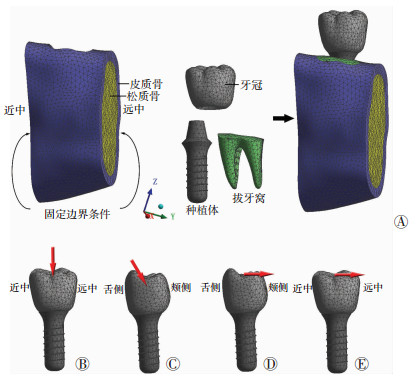
|
| A:有限元模型各组成部分及建立过程;B:轴向加载(AX);C:斜向舌侧45°加载(OL);D:舌颊向加载(LB);E:近远中加载(MD) 图 1 有限元模型各组成部分及加力方向展示 |
| 项目 | 节点数 | 单元数 |
| 皮质骨 | 274 943 | 186 480 |
| 松质骨 | 379 095 | 271 012 |
| 种植体 | 31 818 | 21 356 |
| 牙冠 | 59 144 | 40 822 |
| 拔牙窝 | 38 187 | 24 889 |
1.2 材料属性参数
将模型中各种材料和组织考虑为连续、均质、线性、各向同性的弹性材料,材料变形为小变形,各种材料的力学参数[7]见表 2。
| 材料 | 弹性模量(MPa) | 泊松比 |
| 皮质骨 | 14 000 | 0.30 |
| 松质骨 | 1 400 | 0.30 |
| 钛(种植体) | 96 000 | 0.35 |
| 氧化锆(牙冠) | 110 000 | 0.29 |
| 移植物 | 0.68 | 0.30 |
1.3 加载方式及计算分析
牙冠咬合面加载(图 1),从轴向(axial, AX)、斜向舌侧45°(oblique, OL)、舌颊向(linguo-buccal, LB)、近远中向(mesial-distal, MD),分别以100 N的力加载,比正常咀嚼时的(牙合)力略小。应用有限元分析软件进行计算,输出种植体的位移及种植体骨界面的应力值进行分析。
2 结果 2.1 模型展示本实验成功建立了两组(牙根分叉角度不同组和根柱高度不同组)下颌第一磨牙即刻种植即刻负重的三维有限元模型(图 2)。
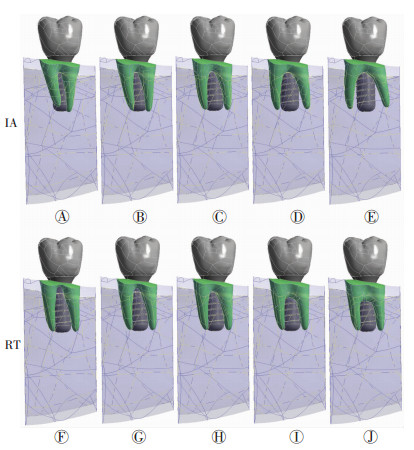
|
| IA:牙根分叉角度;A~E:依次为10°、18°、26°、34°、42°;RT:根柱高度;F~J:依次为1.5、2.1、3.3、4.5、5.3 mm 图 2 下颌第一磨牙即刻种植即刻负重的模型 |
2.2 不同牙根形态时种植体的位移情况
不同牙根形态时种植体的最大位移见图 3,种植体的最大位移中最大值在近远中向加载RT=5.3 mm时出现达0.461 mm,最小值出现在轴向加载IA=42°时,为0.008 mm。详细位移情况见图 4。
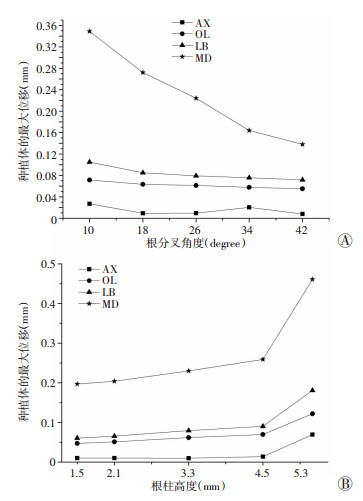
|
| A:根分叉角度分析;B:根柱高度分析 图 3 不同牙根形态时种植体的最大位移 |
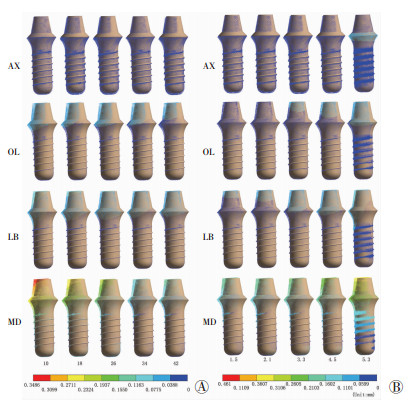
|
| A:牙根分叉角度不同组;B:根柱高度不同组 图 4 不同牙根形态时种植体的位移情况 |
从图 3A和图 4A中可见,牙根分叉角度不同组:随着牙根分叉角度的增大,种植体在4个方向的咬合力作用下,位移均呈下降趋势,但在近远中向加载、舌颊向加载IA=10°时位移大于100 μm;从图 3B和4B中可见,根柱高度不同组:随着根柱长度变长,在4个方向的咬合力作用下,种植体位移均呈上升趋势,但在近远中向加载、舌颊向加载RT=5.3 mm及斜向舌侧45°加载RT=5.3 mm时位移大于100 μm。
2.3 不同牙根形态时种植体周围骨组织的应力分布不同牙根形态时种植体周围骨组织的最大应力分布见图 5,骨界面的最大应力中最大值在近远中向加载IA=10°时出现,最小值在轴向加载IA=18°时出现。具体的应力分布见图 6,图中红色部分为应力大于31 MPa的部位。随着牙根分叉角度变大、根柱长度变短,种植体周围骨界面的最大应力值大体呈下降趋势。轴向加载时骨界面的应力集中于颈部皮质骨及螺纹接触部位较薄弱的松质骨上;斜向和舌颊向加载时应力集中于颈部皮质骨,螺纹接触部位的颊侧松质骨;近远中向加载时应力以颈部皮质骨,螺纹接触的较薄弱的松质骨较为集中。从图 3、图 5可以看出,两组模型中具体到任何一个模型上,4个不同角度加载时,种植体位移、骨组织应力值均是近远中向>舌颊向>斜向舌侧45°>轴向。

|
| A:根分叉角度分析;B:根柱高度分析 图 5 不同牙根形态时种植体周围骨组织的最大应力值 |
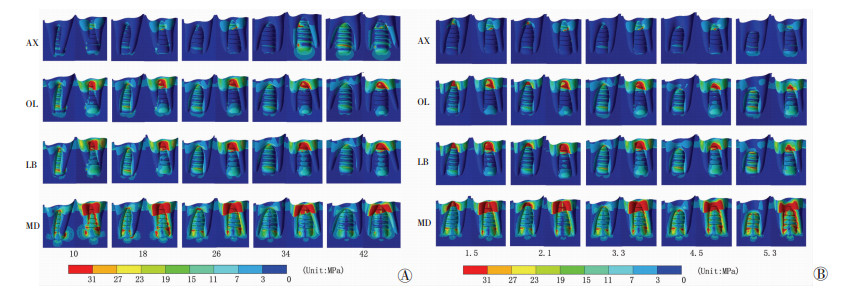
|
| A:牙根分叉角度不同组;B:根柱高度不同组 图 6 不同牙根形态时种植体周围骨组织的应力分布情况 |
3 讨论 3.1 建模考量
本实验所建颌骨模型选取下颌第一磨牙处的基骨,为节段性模型。颌骨简化为节段性的方法已在很多研究中得到应用[8],Kong等[9]也认为加大下颌骨模型时对实验结果没有显著的影响。对于单个种植体生物力学特性的研究,大都采用节段性颌骨模型。本实验将种植体与骨组织界面设为摩擦接触,为了增大种植体骨接触面积以增大摩擦力,我们选用了表面积较大的柱形种植体,尽可能增加种植体稳定性。
种植体植入位置在下颌第一磨牙牙根间隔上。单根牙牙根拔除后即刻植入时种植体可以植入到拔牙窝内,但在磨牙区多根牙的拔牙窝内植入种植体可能会使修复体的位置不十分理想,不利于自洁,增加了种植体周围炎的发生率;且磨牙因拔牙窝周围牙槽骨厚度不足,骨质相对较差,根尖下方重要解剖结构(如上颌窦、下颌神经管等)的限制,大多数情况下磨牙即刻种植时可利用的骨量主要是多根牙牙根间隔处骨和融合根的拔牙窝骨壁,避免伤及根尖下方的其他解剖结构。因本实验主要是研究牙根间隔骨量变化,所以种植体根端与第一磨牙根尖基本平齐。实际工作中若种植体能植入到根尖下方3mm的颌骨内,则种植体骨接触面积大大增加,同时增加了种植体的初期稳定性[10]。研究表明牙齿拔除后颊侧骨吸收大于舌侧[11],为避免后期种植体颊侧颈部螺纹暴露及因骨壁薄应力集中引起骨吸收,所以本实验建模时种植体颈部稍偏舌侧。
种植体表面和拔牙窝壁之间间隙内的组织赋予移植物的弹性模量,使实验模型更贴近临床。临床上即刻种植的病例在种植体和拔牙窝壁之间通常有间隙,若间隙小于2 mm,则自发性愈合的骨组织能长入该间隙;若间隙大于2 mm,则需要使用骨替代材料。这些材料可以加强血凝块的稳定性,有利于新生骨组织长入与种植体之间形成骨结合。Cafiero等[12]研究发现磨牙即刻种植采用引导骨再生术后成功率达到100%。
3.2 结果分析临床上即刻种植时主要通过扭矩扳手来测量种植体初期稳定性。但是有限元分析中只能用位移来评判种植体初期稳定性。本实验结果(图 3、4)显示随着牙根分叉角度增大、根柱长度变短,牙根间隔处骨量增加。4个不同方向加载时随着骨量的增加,种植体位移逐渐变小。近远中向加载时,种植体的位移均大于100 μm,微动较大,这是由于种植体植入后近远中侧骨组织包绕较少所致。舌颊向加载IA=10°时位移大于100 μm,与根分叉角度过小有关;本研究中根柱长度为5.3 mm时,牙根间隔骨高度较低,所以导致舌颊向加载RT=5.3 mm及斜向舌侧45°加载RT=5.3 mm时位移大于100 μm。
合理控制微动,增加种植体的初期稳定性是即刻种植即刻负重种植体获得骨结合的关键。Brunski提出微动理论(micromotion),即在50~100 μm范围内的微动不会妨碍种植体骨界面的形成。微动达到或超过150 μm时,种植体和骨将不会发生骨结合,就会导致种植体周围产生纤维性包膜,形成纤维性愈合[13]。也有学者研究[14]证实微动是影响骨结合的关键因素,即刻负重时控制种植体微动在一定范围内仍可形成骨结合。分析实验结果(图 3、4),我们认为应尽量避免即刻种植即刻修复的修复体受到近远中方向的力,减小舌颊向的咬合力。
随着牙根间隔骨量逐渐增加,4个不同方向加载时种植体周围骨组织的最大应力值相应均呈下降趋势,且在颈部皮质骨及螺纹接触部位较薄弱的松质骨较集中。皮质骨上的应力集中可通过调整咬合力的大小和方向来调节。较薄弱的松质骨因形态不规则很容易发生应力集中,应力值超过31 MPa时,这些部位可能会发生骨折或骨坏死[15]。
从图 3和图 5可以看出,两组模型中具体到任何一个模型上,4个不同角度加载时,种植体位移、骨组织应力值均是近远中向>舌颊向>斜向舌侧45°>轴向。提示磨牙即刻种植即刻负重时尽量避免受到侧向力,特别是近远中向和舌颊向的侧向力。这样一方面增加即刻种植即刻负重种植体的稳定性,另一方面也可以降低种植体颈部骨吸收的程度。临床上即刻种植即刻修复的修复体调整咬合时应稍降低牙尖斜度,避免过大的咬合侧向力。
双根下颌第一磨牙牙根分叉角度(IA)≤10°,根柱高度(RT)≥5.3 mm时,则不建议行种植体的即刻种植即刻负重术。不同牙根解剖形态对下颌第一磨牙即刻种植即刻负重骨结合的形成有一定影响,但是由于不同个体牙根解剖形态多种多样,咬合力大小不一,上下颌骨局部解剖差异,全身状况不同,临床中我们仍然要结合临床和放射学检查谨慎选择病例。
| [1] | 吴展, 李婧, 陈卓凡. 上颌前牙即刻种植即刻修复的临床应用研究[J]. 中国口腔种植学杂志,2012, 17 (2) : 67 –82. |
| [2] | 赖荣康, 甘友志. 即刻种植即刻负载修复单牙缺失的美学效果及患者主观满意度研究[J]. 现代诊断与治疗,2016, 27 (1) : 140 –141. |
| [3] | Atieh M A, Alsabeeha N H M, Duncan W J, et al. Immediate single implant restorations in mandibular molar extraction sockets: a controlled clinical trial[J]. Clinical oral implants research,2013, 24 (5) : 484 –496. DOI:10.1111/j.1600-0501.2011.02415.x |
| [4] | Batchelor P A, Sheiham A. Grouping of tooth surfaces by susceptibility to caries: a study in 5 16 year-old children[J]. BMC Oral Health,2004, 4 (1) : 1 . DOI:10.1186/1472-6831-4-2 |
| [5] | Kerns D G, Greenwell H, Wittwer J W, et al. Root trunk dimensions of 5 different tooth types[J]. International Journal of Periodontics & Restorative Dentistry,1999, 19 (1) : 82 –91. DOI:10.11607/prd.00.0301 |
| [6] | Plagmann H, Holtorf S, Kocher T. A study on the imaging of complex furcation forms in upper and lower molars[J]. Journal of clinical periodontology,2000, 27 (12) : 926 –931. DOI:10.1034/j.1600-051x.2000.027012926.x |
| [7] | Inglam S, Suebnukarn S, Tharanon W, et al. Influence of graft quality and marginal bone loss on implants placed in maxillary grafted sinus: a finite element study[J]. Medical & biological engineering & computing,2010, 48 (7) : 681 –689. DOI:10.1007/s11517-010-0584-3 |
| [8] | de Faria Almeida D A, Pellizzer E P, Verri F R, et al. Influence of tapered and external hexagon connections on bone stresses around tilted dental implants: three-dimensional finite element method with statistical analysis[J]. Journal of periodontology,2014, 85 (2) : 261 –269. DOI:10.1902/jop.2013.120713 |
| [9] | Kong L, Hu K, Li D, et al. Evaluation of the cylinder implant thread height and width: a 3-dimensional finite element analysis[J]. International Journal of Oral & Maxillofacial Implants,2008, 23 (1) : 65 –74. |
| [10] | Zafiropoulos G G, Kasaj A, Hoffmann O. Immediate implant placement in fresh mandibular molar extraction socket: 8-year results[J]. A case report. Journal of Oral Implantology,2010, 36 (2) : 145 –151. DOI:10.1563/AAID-JOI-D-09-00030 |
| [11] | Hayacibara R M, Gon alves C S, Garcez-Filho J, et al. The success rate of immediate implant placement of mandibular molars: a clinical and radiographic retrospective evaluation between 2 and 8 years[J]. Clinical oral implants research,2013, 24 (7) : 806 –811. DOI:10.1111/j.1600-0501.2012.02461.x |
| [12] | Cafiero C, Annibali S, Gherlone E, et al. Immediate transmucosal implant placement in molar extraction sites: a 12-month prospective multicenter cohort study[J]. Clinical oral implants research,2008, 19 (5) : 476 –482. DOI:10.1111/j.1600-0501.2008.01541.x |
| [13] | 刘宝林. 现代口腔种植学[M]. 北京: 人民卫生出版社, 2011 : 4 -5. |
| [14] | Szmukler-Moncler S, Piattelli A, Favero G A, et al. Considerations preliminary to the application of early and immediate loading protocols in dental implantology[J]. Clinical oral implants research,2000, 11 (1) : 12 –25. DOI:10.1034/j.1600-0501.2000.011001012.x |
| [15] | Lin C L, Lin Y H, Chang S H. Multi-factorial analysis of variables influencing the bone loss of an implant placed in the maxilla: prediction using FEA and SED bone remodeling algorithm[J]. Journal of biomechanics,2010, 43 (4) : 644 –651. DOI:10.1016/j.jbiomech.2009.10.030 |



